At NeoCon Sven Govaars & Dean Strombom Take Aim

One of our favorite partnerships in the design biz is that of design minds Sven Govaarsand Dean Strombom. Each year at NeoCon, they debut a new seminar full of ideas, strategies and project work that has followed a careful evolution of thought. If you’ve gone on the journey with them, as we have, you’ll know that Mr. Govaars recently took a leap across the country, from Houston to San Francisco, and from Genslerto Steelcase, as Principal, Applied Research + Consulting.
We were very happy to learn that their partnership would continue as Mr. Govaars settled into work-life at Steelcase – a 2018 seminar would be happening! We hopped on the freight elevator up to the 19thfloor Monday afternoon during the show and tuned into “Take Aim…A Quiver of Strategy Tools.”
In their introduction, Strombom, Principal at Gensler, noted:
“Every year we see the same information surface in surveys, interviews, employee satisfaction reports – workplaces are considered less optimal than they could be by the workers who use them. And this is across industries and sectors. We know it’s complicated and we know it could be better. We also know that when clients come to us we are charged and challenged to help them – and ourselves – in establishing a clear design strategy. So – how do we do this? How do we listen, discover and synthesize our clients vision? That became our central question.
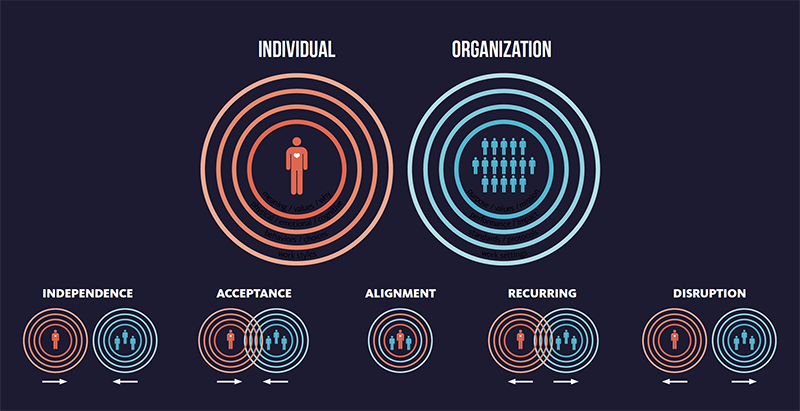
Govaars chimed in, saying “This talk is a departure from the usual case studies, showing you our work or quoting a lot of statistics and secondary research. Over the next 45 minutes or so we will share with you a clear approach and design tools for engaging clients to rapidly surface, evaluate and implement design strategies with successful outcomes. And we’ll have a little fun along the way.” And one last thing – if you keep doing the same thing you will more than likely get the same result – hence – our theme of arrows in the quiver. What if you could use your arrows differently?”

This talk was all about specifics – the howbehind the what and why; the steps and tools designers can use to execute the kinds of ideas Govaars and Strombom presented in previous years.

“We’ve covered a lot of the ‘why’ and ‘what’ – showing our work, but we wanted to offer more specific tools and helpful knowledge,” said Mr. Strombom, in a post-seminar interview. “Many people who’ve followed our previous seminars have reached out to us and said, ‘This is all interesting stuff, but how do you do it? What tools do you use to make sure the project is successful?’ This year we wanted to give the audience some insights to the strategy work behind the ‘why’.”
Reading Material / Simon Sinek
Govaars and Strombom referenced Simon Sinek in his TED Talk, ranked the third most popular TED Talk of all time. Sinek’s leadership model circles around the question ‘why’? Clocking in at just under 18 minutes, it’s the perfect thing to check out during your commute to work or on a run.
Govaars and Strombom stressed the importance of searching for and crafting the bigger picture.
“When we look at the design process separated into parts and passed off along the way, we don’t always get to see the whole,” said Mr. Strombom. “The same is true when we consider the needs of organization without taking into account what the individuals need to thrive – marginal success at best. The closer we can align the success factors of individuals and the organization, the better the outcome for both. We’re trying to find that perfect alignment.”
That holistic picture equally balances the workspace with the organization – and especially with the people. Multiplied together, these variables’ impact on the final result can be enormous.
“There’s often a lot of emphasis on place in workplace strategy, as it should be, but we also need to focus on the people who will be using the spaces,” said Mr. Govaars. “We may have created some great spaces, but people might not know how to use them. Think about the people not as an afterthought but as a starting point.”
And now, the arrows in your quiver! Govaars and Strombom spent the majority of their presentation outlining the specific “arrows” (tools) they have used, and which all designers might consider in order to create great spaces in which end users can perform at a higher level. They presented a “periodic table of tools and resources” (shown), giving attendees a sense of how things come together, and how a design team goes about picking out what tools they need.
Below are integral pieces of a design team’s process:
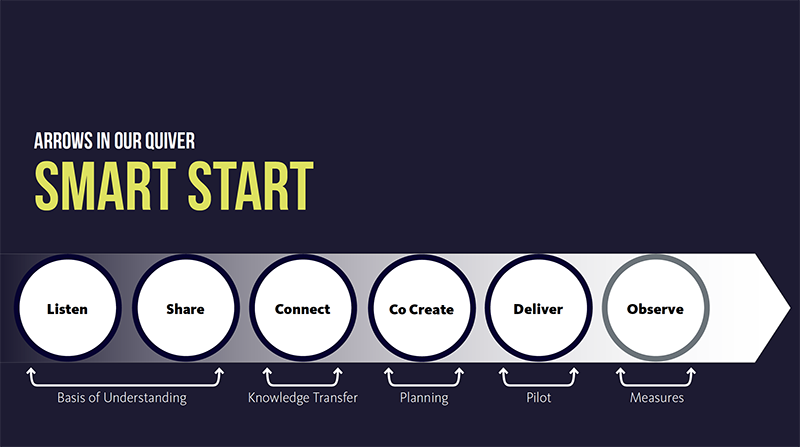 >SMART Start.Most design firms have some type of visioning process in place, and SMART Start, which Govaars and Strombom have presented in previous talks, is a great version of that. The SMART acronym stands for Specific, Measurable, Accountable, Reliable, Timely. SMART Start uses the following structure: Listen and Share, (forming a basis of understanding) Connect (knowledge transfer), Co Create (planning phase), Deliver (pilot) and Observe (measures)
>SMART Start.Most design firms have some type of visioning process in place, and SMART Start, which Govaars and Strombom have presented in previous talks, is a great version of that. The SMART acronym stands for Specific, Measurable, Accountable, Reliable, Timely. SMART Start uses the following structure: Listen and Share, (forming a basis of understanding) Connect (knowledge transfer), Co Create (planning phase), Deliver (pilot) and Observe (measures)
“SMART Start needs to happen at the project’s inception, as it’s about getting all stakeholders in the same room, including leadership and the end users, to get the project off on the right foot,” said Mr. Strombom.
>Workshops.Workshops are one of the most powerful arrows in your quiver; it’s where you capture the “why” with the client. Within these strategy workshop sessions, design teams can identify challenges and solutions in design thinking, strategic planning, culture, performance, agility, innovation, organizational change, business strategy and user experience. The sessions should be “collaborative, face-to-face events to share information, insights, goals and objectives.”
“We find that often times teams spend maybe one or two hours in a project kickoff/visioning session (referred to above as the SMART Start), and rarely a half day or full day,” said Mr. Strombom, during the seminar. “It’s very difficult to gather all the information and insight needed in that single, relatively short session. There needs to be a comprehensive series of follow up workshops with the appropriate stakeholders, each addressing specific themes that will impact the total project result.”
An important step in the workshop process is how you, the design team, and the client, come together. There’s a lot to discuss, so “establishing goals, aligning points of view, and asking the right questions at the onset of the project sets the stage and tone from strategy to execution.”
“Prepare them in advance on what they’re going to be doing ahead of time,” said Mr. Govaars. For example, he noted, “When you come in and begin talking about the project at a high level, you also need to come in at practical level, addressing things like project scope and budget. You are helping the client self-discover what matters most and what the key drivers are for their organization and their people.”
And who should be in this workshop? “We advise as many as possible, even if it means we need to hold multiple sessions” said Mr. Strombom. “People need to be heard.”
>Inclusivity.It gets its own arrow because of the power manydiverse voices can have on the project. More voices does create the possibility of chaos, but it can be positive chaos with the help of a workshop facilitator.
Designate a point person, or facilitator, who helps clients “navigate through the complexities of meetings, workshops and events.”
“A facilitator moves the conversation forward,” noted Mr. Strombom. “It’s a very specific role in advancing the workshop process. The facilitator can come from either the client side or design side or third party – the point is to have someone who can center the discussion and draw out a holistic perspective. They’re making sure all questions and areas of concern are being covered in the workshop, rather than just a few.”
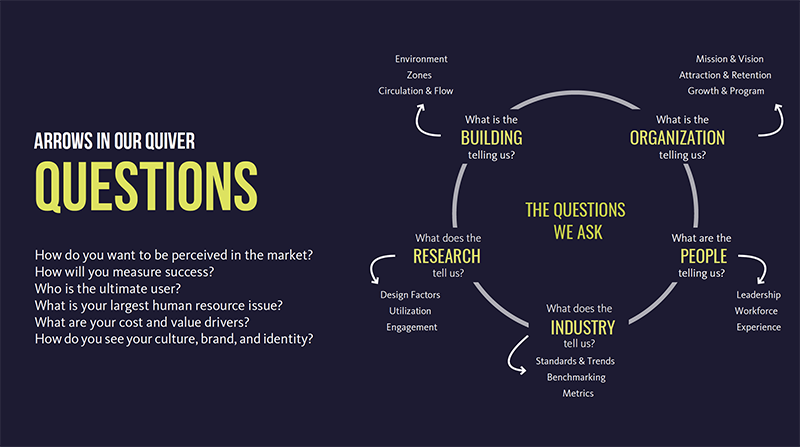 >Questions.There are five general areas of questioning that should come up in workshop sessions:
>Questions.There are five general areas of questioning that should come up in workshop sessions:
-What is the BUILDING telling us? (Environment Zones, Circulation & Flow)
-What is the ORGANIZATION telling us? (Mission and Vision, Attraction & Retention, Growth & Program)
-What are the PEOPLE telling us? (Leadership, Workforce, Experience)
-What does the INDUSTRY tell us? (Standards & Trends, Benchmarking, Metrics)
-What does the RESEARCH tell us? (Design Factors, Utilization, Engagement). Note: Find primary sources as often as possible. If using secondary forms of research, find a date of publication on Internet sources to ensure the findings are not dated.
Sample questions include: How do you want to be perceived in the market? How will you measure success? Who is the ultimate user? What is your largest human resource issue? What are your cost and value drivers? How do you see your culture, brand and identity?
>Connect.This arrow addresses change management, involving three areas knitted together: leadership, engagement, communication. All engagement activities should promote two-way dialogue. Leadership support should come from multiple leaders at multiple levels. Communication is a strategy in itself and should involve timely, smart, repetitive messages through a variety of messaging channels.
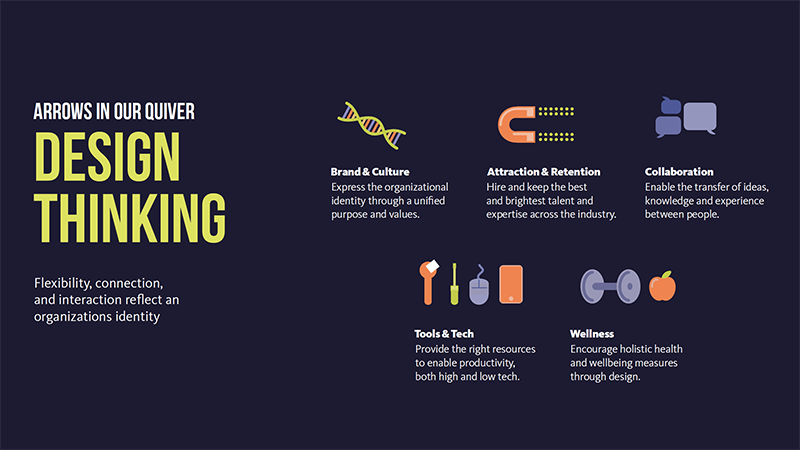 >Design Thinking. “Rather than thinking of the traditional problem/solution approach, we need to use design thinking to open up possibilities,” said Mr. Govaars. “You can ask questions, generate idea and insights to prototype them quickly and start the process all over again quickly and efficiently – a more holistic rather than linear way of developing a design strategy.”
>Design Thinking. “Rather than thinking of the traditional problem/solution approach, we need to use design thinking to open up possibilities,” said Mr. Govaars. “You can ask questions, generate idea and insights to prototype them quickly and start the process all over again quickly and efficiently – a more holistic rather than linear way of developing a design strategy.”
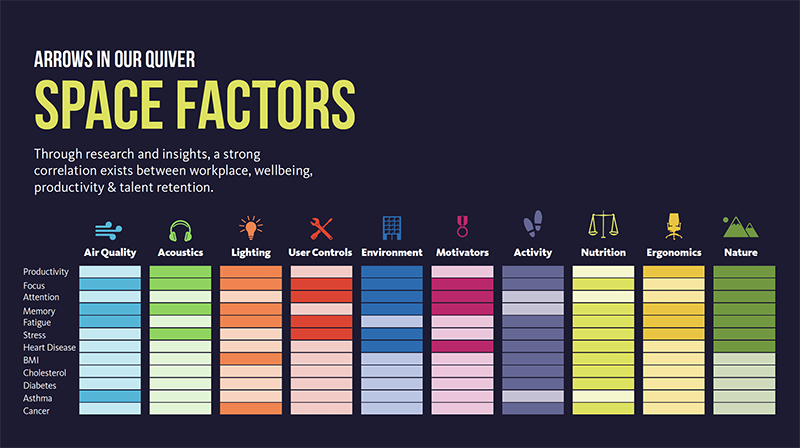 >Space Factors.“Through research and insights, a strong correlation exists between workplace, wellbeing, productivity and talent retention.” Presented in their previous talks, the following space factors have varying effects on everything from productivity, focus, memory, fatigue and stress to heart disease, BMI, cholesterol, diabetes, asthma and cancer: Air Quality, Acoustics, Lighting, User Controls, Environment, Motivators, Activity, Nutrition, Ergonomics and Nature. They all – to some degree – impact physical (feel better), emotional (wellbeing) and cognitive (think better) health.”
>Space Factors.“Through research and insights, a strong correlation exists between workplace, wellbeing, productivity and talent retention.” Presented in their previous talks, the following space factors have varying effects on everything from productivity, focus, memory, fatigue and stress to heart disease, BMI, cholesterol, diabetes, asthma and cancer: Air Quality, Acoustics, Lighting, User Controls, Environment, Motivators, Activity, Nutrition, Ergonomics and Nature. They all – to some degree – impact physical (feel better), emotional (wellbeing) and cognitive (think better) health.”
>Performance.Thinking about performance is a really powerful piece because it deals with the feasibility of a project. “It’s something that should be thought about both pre- and post-completion, as well as during,” said Mr. Govaars. “It’s where you create the criteria around which people are aligned. Some are more important than others to the client, and you need to get a sense of which ones are larger priorities, then address them concretely before, during and after completion. Find a way to put a value to each with the client, coming to a consensus that you can refer back to.”
Govaars and Strombom outlined six factors design firms and their clients should use to measure performance:
-Economical: Do the benefits outweigh the capital outlay?
-Operational: Can we create it? Can we sustain it? How long?
-Experiential: What is the staged vs. created? Does it make sense?
-Educational: Will it drive research or build knowledge?
-Technical: Do we have the right tools and resources to do it?
-Social: How does this affect our people and community?
Note: Of the six factors, only one – economical – is specifically financially concerned. “Anecdotally people like to say that workplace design is not about the money and yet we all know it is a huge driver for most companies so all the factors need to be monetized in some way,” said Mr. Govaars.
>Score Card. The Balanced Scorecard was originally developed by Kaplan and Norton in 1992 to help businesses evaluate their companies from multiple perspectives: employees, customers, financial and business process. Strombom and Govaars believe it is a good design tool to consider in generating the underlying basis for a design strategy. “With a tool like this, you can establish the project purpose, what success looks like from multiple perspectives and establish ways to measure that success along the way and in post-occupancy,” said Mr. Strombom.
>Stories.“User experience studies, avatars and journey mapping tools create the basis for “story doing”, shifting thinking to designing experiences versus designing environment.” Create a journey map traveling through the activities, environments and objects that people will encounter and use. When you’re mapping out these experiences and working with the client, the executive story is not often the same story you need to tell the workforce. Find all relevant stories and work with the client to express them successfully.
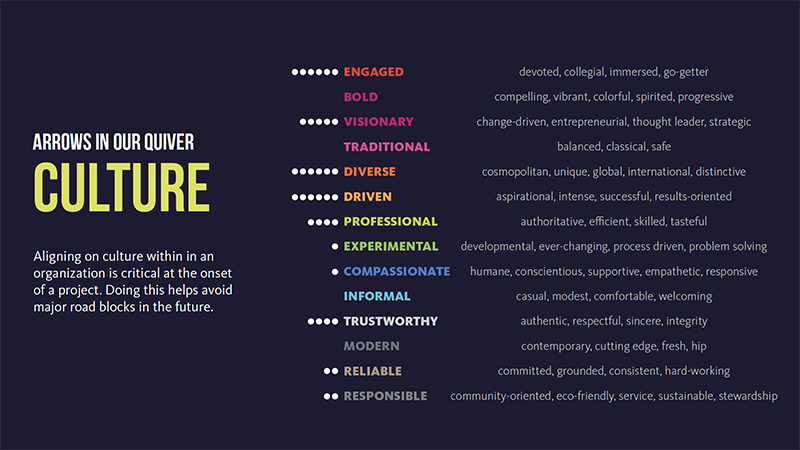 >Culture.Discussed in previous talks, aligning on culture within the organization at the beginning of a project is invaluable. Govaars and Strombom presented a culture visioning session that includes asking people from all levels of the organization to prioritize a series of words that describe them as a company, including: engaged, bold, visionary, traditional, divers, driven, professional, experimental, compassionate, informal, trustworthy, modern, reliable and responsible.
>Culture.Discussed in previous talks, aligning on culture within the organization at the beginning of a project is invaluable. Govaars and Strombom presented a culture visioning session that includes asking people from all levels of the organization to prioritize a series of words that describe them as a company, including: engaged, bold, visionary, traditional, divers, driven, professional, experimental, compassionate, informal, trustworthy, modern, reliable and responsible.
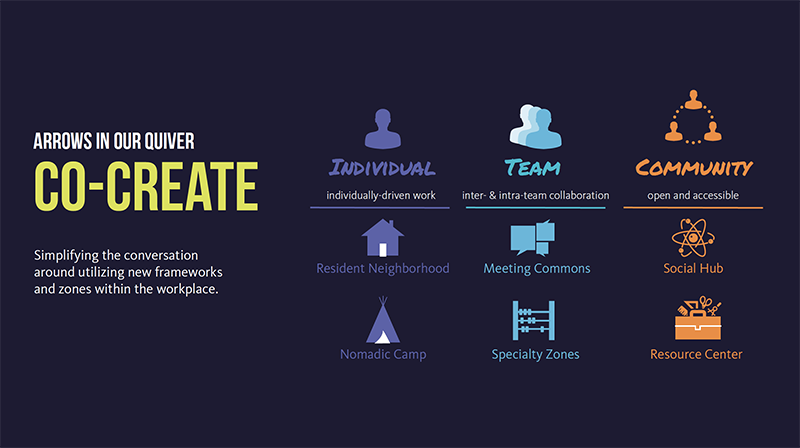 >Co-Create. “Designers may know more about workplace design than their clients but no one will know more about the organization than the client, which is why co-creation is vital to a successful project,” said Mr. Govaars. “And together the design strategy needs to be looked at from multiple perspectives: the individual, the team and the community or organization at-large. And when co-creating, the conversation can be simplified by developing simple frameworks around zones and settings.”
>Co-Create. “Designers may know more about workplace design than their clients but no one will know more about the organization than the client, which is why co-creation is vital to a successful project,” said Mr. Govaars. “And together the design strategy needs to be looked at from multiple perspectives: the individual, the team and the community or organization at-large. And when co-creating, the conversation can be simplified by developing simple frameworks around zones and settings.”
Quoted / Austin Cleon:
“Steal like an artist. Steal from the best, and leave the rest, but always, always make it your own.” – Austin Kleon, “Steal Like an Artist: 10 Things Nobody Told You About Being Creative”
>Measures.Questions design firms should be asking include: Is the space working? Are people using the space as designed? Are there any unexpected outcomes? What are things that can easily be changed that would make a big change? The answers design firms need should involve occupancy, movement, wellbeing, work modes and time.
The presentation was a major success at NeoCon, with many people following up for more information and positive feedback.
“One of the reasons Dean and I felt this one worked is that we were discussing how we derive our ideas and insights for design and creating great experiences, and we did not dwell on why or what we created,” said Mr. Govaars, after the seminar. “I also think there was a bit of interest in how Dean and I – now from different firms – could collaborate and create from a similar foundation. It would be understandable to those who have followed our eight years of talks.
“At the conclusion of the talk we raised the point that this approach and design tools were not specific to one project or client and can be used to solve all types of problems or design challenges. Those in the audience need to find their own way to learn and grow from their work,” Mr. Govaars said. “Change continually alters our context, and it is difficult to know what problems or opportunities we may encounter next.”
Mr. Strombom added, “The more arrows in your quiver the better when you’re developing design strategies while listening, observing and learning about the needs of individuals and organizations in the discovery phase of a project. That is one of the reasons we continue to explore these topics each year.”



